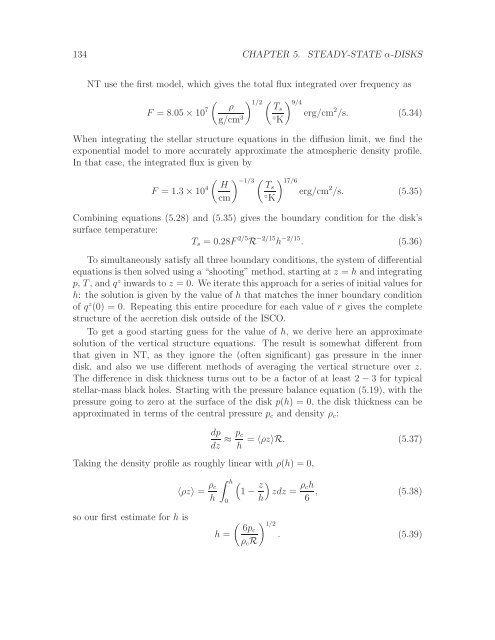Radiation Transport Around Kerr Black Holes Jeremy David ...
Radiation Transport Around Kerr Black Holes Jeremy David ...
Radiation Transport Around Kerr Black Holes Jeremy David ...
Create successful ePaper yourself
Turn your PDF publications into a flip-book with our unique Google optimized e-Paper software.
134 CHAPTER 5. STEADY-STATE α-DISKS<br />
NT use the first model, which gives the total flux integrated over frequency as<br />
( ) 1/2 ( ) 9/4 ρ<br />
F = 8.05 × 10 7 Ts<br />
erg/cm 2 /s. (5.34)<br />
g/cm 3<br />
When integrating the stellar structure equations in the diffusion limit, we find the<br />
exponential model to more accurately approximate the atmospheric density profile.<br />
In that case, the integrated flux is given by<br />
◦<br />
K<br />
) −1/3 ( ) 17/6 Ts<br />
erg/cm 2 /s. (5.35)<br />
F = 1.3 × 10 4 ( H<br />
cm<br />
◦<br />
K<br />
Combining equations (5.28) and (5.35) gives the boundary condition for the disk’s<br />
surface temperature:<br />
T s = 0.28F 2/5 R −2/15 h −2/15 . (5.36)<br />
To simultaneously satisfy all three boundary conditions, the system of differential<br />
equations is then solved using a “shooting” method, starting at z = h and integrating<br />
p, T, and q z inwards to z = 0. We iterate this approach for a series of initial values for<br />
h: the solution is given by the value of h that matches the inner boundary condition<br />
of q z (0) = 0. Repeating this entire procedure for each value of r gives the complete<br />
structure of the accretion disk outside of the ISCO.<br />
To get a good starting guess for the value of h, we derive here an approximate<br />
solution of the vertical structure equations. The result is somewhat different from<br />
that given in NT, as they ignore the (often significant) gas pressure in the inner<br />
disk, and also we use different methods of averaging the vertical structure over z.<br />
The difference in disk thickness turns out to be a factor of at least 2 − 3 for typical<br />
stellar-mass black holes. Starting with the pressure balance equation (5.19), with the<br />
pressure going to zero at the surface of the disk p(h) = 0, the disk thickness can be<br />
approximated in terms of the central pressure p c and density ρ c :<br />
dp<br />
dz ≈ p c<br />
h<br />
Taking the density profile as roughly linear with ρ(h) = 0,<br />
〈ρz〉 = ρ c<br />
h<br />
∫ h<br />
0<br />
= 〈ρz〉R. (5.37)<br />
(<br />
1 − z )<br />
zdz = ρ ch<br />
h 6 , (5.38)<br />
so our first estimate for h is<br />
h =<br />
( ) 1/2 6pc<br />
. (5.39)<br />
ρ c R
















